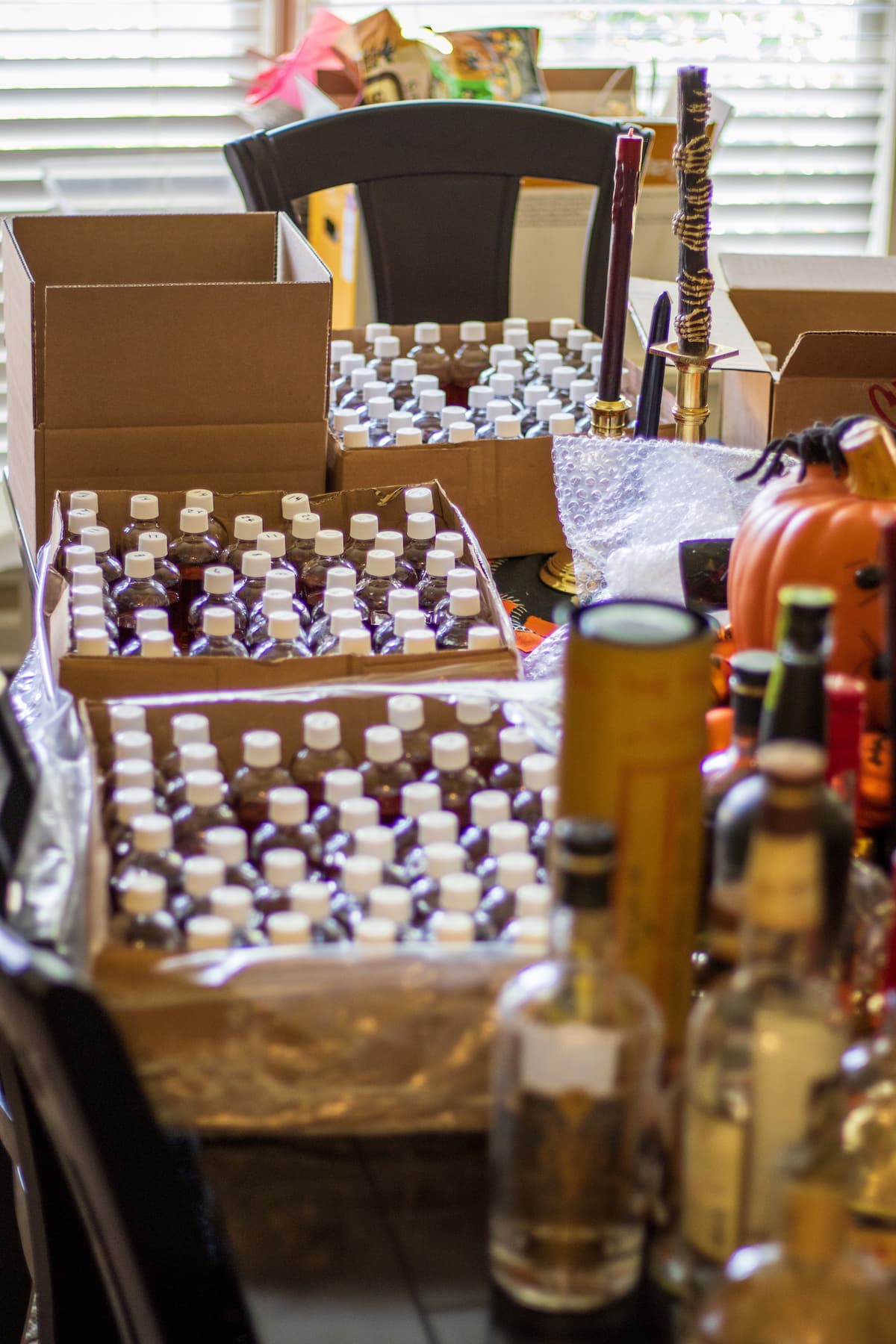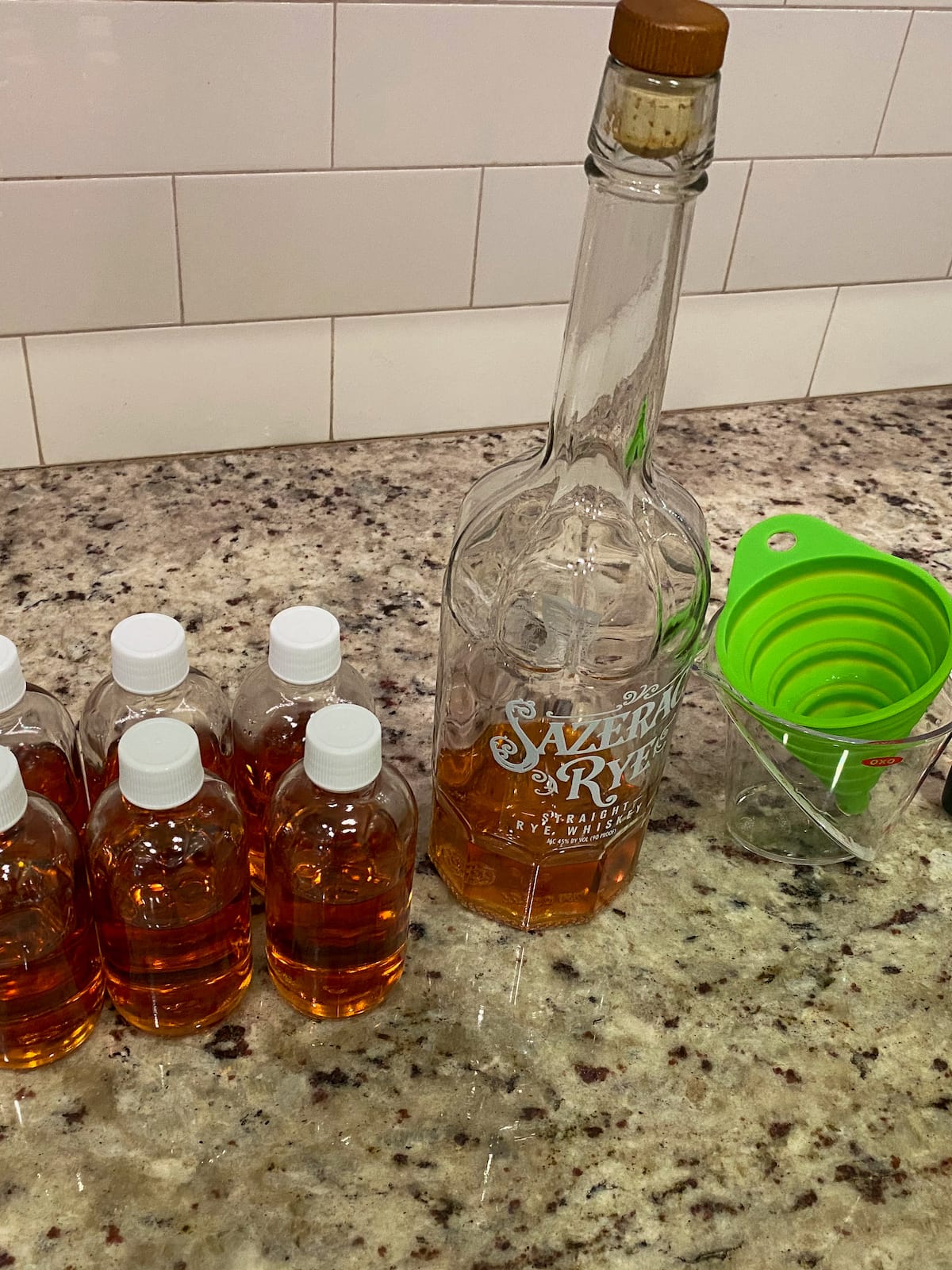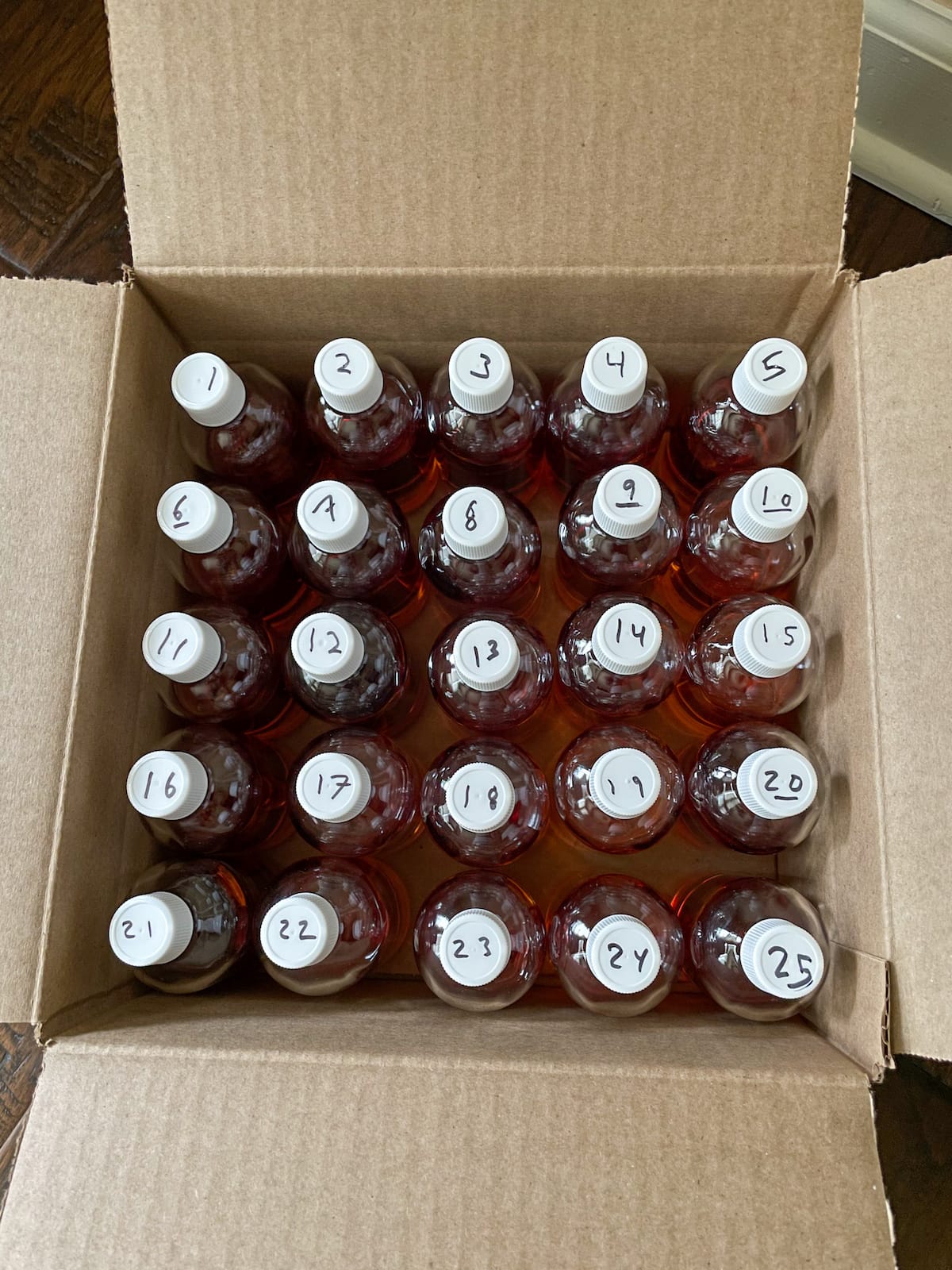A whiskey advent calendar is a great way to try new whiskeys. Plus it makes a fun treat for whiskey lovers during the holidays. When I started looking for one I encountered a few drawbacks. The first issue I came across, state liquor laws. In Alabama, like many other states, liquor laws can make it extremely difficult or impossible to order liquor online. If there are whiskey advent calendars to buy within the state I couldn’t find one.
The next issue I discovered, price. Even if you’re able to order one online the prices are upwards of $200 for relatively small amounts of whiskey. The size of the pour for the price wouldn’t be as much of an issue if it wasn’t for the next drawback, selection. Most of the whiskey advent calendars I found were filled largely with big brand, easy to find labels. I’m not knocking budget or big label whiskey, but for $200 I don’t want a 30ml pour of Jack Daniels.
So, I decided to take matters into my own hands. Keep reading to learn how I built my own whiskey advent calendar and what I learned along the way. Fair warning, your dining room will turn into a whiskey warzone for a little bit so warn your spouse.

Recruit some friends
You could do this alone, but you’d have to shell out some serious cash or settle for minis. I considered the mini route but found the local selection of minis to be too poor. Recruiting friends helps keep the cost down, and helps with bottle hunting. It is particularly helpful if you can recruit friends in different geographic regions to increase bottle selection.
In addition to making things cheaper and easier, having friends join you is fun! Not only will drinking a different whiskey every day for almost a month be more fun with friends, it seems a little less unhealthy too. I recommend finding one or two friends early that will be really into the idea.
These friends will be useful in recruiting other friends. What whiskey drinker could say no to a whiskey advent calendar? Your initial group can also help you decide on some parameters before your group grows. If one of your founding group hates Scotch you’re going to want to avoid doing a Scotch themed calendar. Do you have friends that agree to things then flake out? Don’t invite those friends. Also, consider the overall financial commitment when picking your group. Everyone needs to be on the same page when it comes to budget. Whiskey can get expensive quickly, but it doesn't have to. My group ended up spending $1,593.11 total or about $200 a person, including supplies.
Start making a plan
One of the decisions your founding couple recruits will have to make is what size pour you’re looking for. The number of participants is going to depend on or control how much whiskey everyone gets each day. A standard 750ml whiskey bottle contains 25.4 ounces (I found many contained a fair amount more). If you wanted 2 ounce pours then you would want a group of 12. We decided on 3 ounce pours so we went with 8, ultimately it’s all math.
Part of your decision should consider what size bottles are available. I recommend researching and pricing bottles early in the process. I expected that part to be easier than it was. Make sure you get a bottle that is slightly but not too much, larger than your decided pour. This isn't something you can do for a reasonable price on Amazon, remember you're going to need a bunch of bottles, 200 in our case. We ended up deciding on a 4 ounce bottle from LiquidBottles.com. When you order you bottles, don’t forget the tops.

Time to pick whiskey
This is where the fun really starts. Your founding group should have come up with a basic plan. For instance, we’re mostly bourbon and rye drinkers, so this year we limited our selection to American whiskeys. If you’re a Scotch drinker you’d want to include Scotch. I think a Scotch whiskey advent calendar exploring the Scotch regions would be fun.
I highly recommend you discuss an acquisition plan. If you’re doing a full 24-day calendar you’re going to need 24 different whiskeys. We started a shared Google Sheets page with whiskeys we were interested in and their MSRP. We enjoy the hunt so we weren’t willing to pay inflated secondary prices. You can really nerd out on this if you want. We used the MSRP field to create a rough estimate of what we would be spending. Then we made a formula cell that divided that among us. We also added the actual price paid and a separate function cell that kept a running per person tally. Our sheet also included a drop-down selection to code who bought each bottle. This is overkill, but we're nerds.
Logistics
Communication is key. Your acquisition plan should have more than 24 bottles on it. You’ll want to include several bottles that aren’t something you can just walk into a store and pick up. Hunting those bottles over the course of the year as a team is half the fun. I recommend hunting hard to find bottles and stocking up on the must-haves for your list first. Save the easier bottles for the end when you’re pretty sure you’re not going to find that MSRP Pappy 23. Everyone (or a designated person) must add their purchases to the shared sheet so duplicates aren’t purchased.
I recommend all the bottles get transferred to the organizer as soon as possible after they’re acquired. It is much easier for one person to keep up with all the bottles in a designated place (in my case my one-year-old daughter’s closet), than it is for several people to remember the odd bottle here or there that shouldn’t be opened. It also makes for fun pictures to share with the group as the collection grows.
How split the costs
If you’ve planned well there shouldn’t be many surprises here, just more logistics. You could do this a number of ways. The Google sheet will (if designed correctly) keep up with who has paid what, but someone will still have to calculate the differences. Depending on how your group is set up you could set price ranges for bottles and have each participate provide a certain number of bottles. The organizer could assign bottles for each person to get in an equitable fashion, or any number of options.
Or you could forget about all those complications and let technology do the heavy lifting for you. We used the free version of Splitwise to coordinate all the payments and division. It works well for people who just want to contribute financially and for people who want to bottle hunt. It also eased the financial pain. When a bottle is purchased the price is immediately distributed across the group so it was generally $5-8 at a time. I’m not sponsored by Splitwise, but I use it for anything that involves more than 2 people or more than one transaction. Everyone entered bottles as they purchased them and I put in supplies such as the bottles and boxes.
The pour
Or more accurately the pours. In our case 200 of them. This is again where preparation comes in. You do not want to be starting this process on November 28th. I recommend starting the first pour in the first week of October. This gives you enough time to order supplies when you realize you don’t have everything you need. But without putting you in a situation where you’re pouring so early your whiskey is going to get stale.
Start with your cheapest, easiest to find bottle. If you screw up you can go grab another without too much pain. If you’re lucky you’ll have a funnel on hand that fits perfectly into your bottles but don’t hold your breath. This was a surprising snag for me. After carrying a small bottle into about 10 local stores (Target and Bed, Bath, and Beyond only sell one funnel and it’s the same one!), I ended up ordering this one on Amazon and it fit the neck of our bottle perfectly.
You’ll also need a way to repeatedly measure the same amount with relative accuracy. I found this OXO measuring cup measured 3 ounces well and also poured well without dribbling. I tried to come up with a more exacting scientific method, but this was the best I could do. I’d love to hear suggestions in the comments.
Once I got my process down I tried to pour a bottle or two a night. I hit my stride by mid-October and ending up pouring about 10 in one night to meet a deadline to get the boxes distributed. You will get a feel for pouring and realize you don’t have to be 100% exact. After trying to be exact for the first few pours, I realized there was more whiskey in each bottle than advertised. I loosened up and started focusing on being relatively close and erring on the size of not shorting any pour.
Depending on how you split up your group you’ll likely encounter a couple of ounces of whiskey left in each bottle. You have a couple of options. You could top up each bottle and try to keep it equal, treat yourself after each pour, or you could blend them.

The blend
When we started planning the whiskey advent calendar, I quickly realized there would be around an ounce and a half left in each bottle after the pour. We already had generous pours, and trying to top up 8 bottles equally seemed like too much trouble. Treating myself to the extra after each pour would ruin the surprise of any new bottles (if you've planned well there should be several), and would have made pouring several bottles a night interesting.
If you follow Holmes Cooks you know that I enjoy the occasional self blended whiskey. I also keep coming across discussions about infinity bottles. Add those things together and you have a solution to the last couple ounces in each bottle. My first few pours I carefully measured each pour assure leftovers. After a few, it became clear that the 25.3 ounces adverstized is a minimum threshold. I quickly realized most bottles had two to three ounces remaining so my blend bottle was going to fill up fast.
This being a clearly scientific endeavor, I measured and noted each addition to the blend bottle. I soon realized the empty .750ml wasn't going to cut it and I (begrudgingly) emptied my lowest 1.75l to house the blend. After the first ten or so curiosity got the best of me and I snuck an ounce of the blend. It was amazing. I'm looking forward to what it ultimately becomes. As a bonus for whoever puts in all the hard work of pouring the calendar, I ended up with about a half-liter extra of the blend. Here's hoping it's good!
If you have friends who are good at math, like I do, then once you have the full blend bottled you can have them take the amount of each whiskey in the blend along with its proof and mash bill to calculate the final proof and mash bill of your blend. We tend to like ryes, high rye whiskeys, and higher proofs which steered our blend. Our final blend landed at 104 proof and still a bourbon, but with an extremely high rye percentage. The final mash bill ended up at 61% corn and 25% rye rounded out with a healthy amount of wheat and a little malted barley.
The distribution
If you've gotten this far, the real fun is about to begin. When I started this project I planned to handmake some nice wooden boxes for everyone, but my wife's eye roll in February proved correct. Pro tip, don't promise the guys things you can't come through on, or they'll ask you about those damned boxes every day. In the end, I had 200 tiny glass bottles of whiskey and nothing to put them in.
Since none of them were being shipped (there's a bunch of legal stuff involved with shipping booze that is beyond the scope of this post) I didn't need special padding or anything. My initial search turned up empty so I ended up just taking a tape measure to a 5x5 grid of my bottles and going to the UPS Store. It cost me a little over $50, but the boxes were the perfect size.
We used the same distribution method of various traveling friends and family members that brought all the bottles together to distribute all the boxes. Getting the pours done in early November helped capitalize on folks traveling for Thanksgiving. Everyone had their boxes with more than a week to spare.

The drinking
Here's the reward for months of work! Before you crack open your first bottle though you have to decide one aspect I've left out. Bottle order. We discussed several ways of doing this, a draft, a vote, a violent group discussion, but in the end we went with the true advent calendar style daily surprise.
Before I started pouring, I took our bottle list and a blank calendar sheet and planned the order. It is a little daunting at first, but if you have a group that will let you do pick the days, I highly recommend it. I really enjoyed planning the order and setting up a tour through a certain distillery or comparing a new vs an old school bottled-in-bond whiskey. It also keeps the group engagement high.
We have a Signal group just for the guys in the whiskey advent calendar, and each day I send out an email with what is in that day's bottle. I've really enjoyed researching origins and stories for each whiskey and finding tasting notes and reviews to link. And eight friends from across the Southeast get to spend the Advent season talking daily about something that brings them joy. Isn't that what it's all about?
Our whiskey advent calendar
Below is what we ended up with for 2020:
- Henry McKenna Single Barrel by Heaven Hill
- Elijah Craig Small Batch by Heaven Hill
- Heaven Hill Bottled-in-Bond by Heaven Hill
- Dettling Single Barrel Cash Strength by Big Escambia Spirits
- New Riff Kentucky Straight Rye by New Riff Distilling
- E. H. Taylor, Jr. Small Batch by Buffalo Trace
- Old Forester 1920 Prohibition Whiskey by Old Forester/Brown-Foreman
- Old Grand-Dad 114 by Beam Suntory
- Rabbit Hole Dareringer by Rabbit Hole Distilling
- Sazerac Rye by Buffalo Trace
- Kentucky Owl Confiscated by Kentucky Owl
- Woodford Reserve Double Oaked by Woodford Reserve/Brown-Forman
- Willet Family Estate Rye by Willet
- Old Ezra 7 by Ezra Brooks
- Whistle Pig Piggyback by Whistle Pig
- Weller Antique 107 by Buffalo Trace
- Eagle Rare by Buffalo Trace
- Stagg Jr. by Buffalo Trace
- Campfire by High West
- Elijah Craig Barrel Proof by Heaven Hill
- A Midwinter Night's Dram by High West
- Maker's Mark 101 by Beam Suntory
- Maker's Mark Cask Strength by Beam Suntory
- Blanton's by Buffalo Trace
I'd love to hear what others have done or ideas for how to change it up next year! Let me know your favorite whiskey, or if you decide to give the advent calendar a shot in the comments below!



Leave a Reply